Unit 35: Developing Individuals, Teams and Organizations Report
VerifiedAdded on 2020/10/22
|16
|4525
|220
Report
AI Summary
This report provides a comprehensive analysis of developing individuals, teams, and organizations within a business context, focusing on the role of Human Resources. It begins by defining the essential knowledge, skills, and behaviors required of HR professionals, emphasizing the importance of technical knowledge, ethical standards, collaboration, leadership, communication, and adaptability. A personal skills audit and development plan are presented for an HR consultant, identifying strengths, weaknesses, opportunities, and threats, along with specific learning objectives. The report then differentiates between organizational and individual learning, training, and development, highlighting their respective impacts. It explores the necessity of continuous learning and professional development for driving sustainable business performance, followed by an examination of how High-Performance Work Practices (HPWPs) contribute to employee engagement and competitive advantage. Finally, it evaluates various performance management approaches and demonstrates their support for cultivating a high-performance culture and commitment within an organization. The report uses the case of Whirlpool to illustrate key concepts and provides a practical framework for HR development.
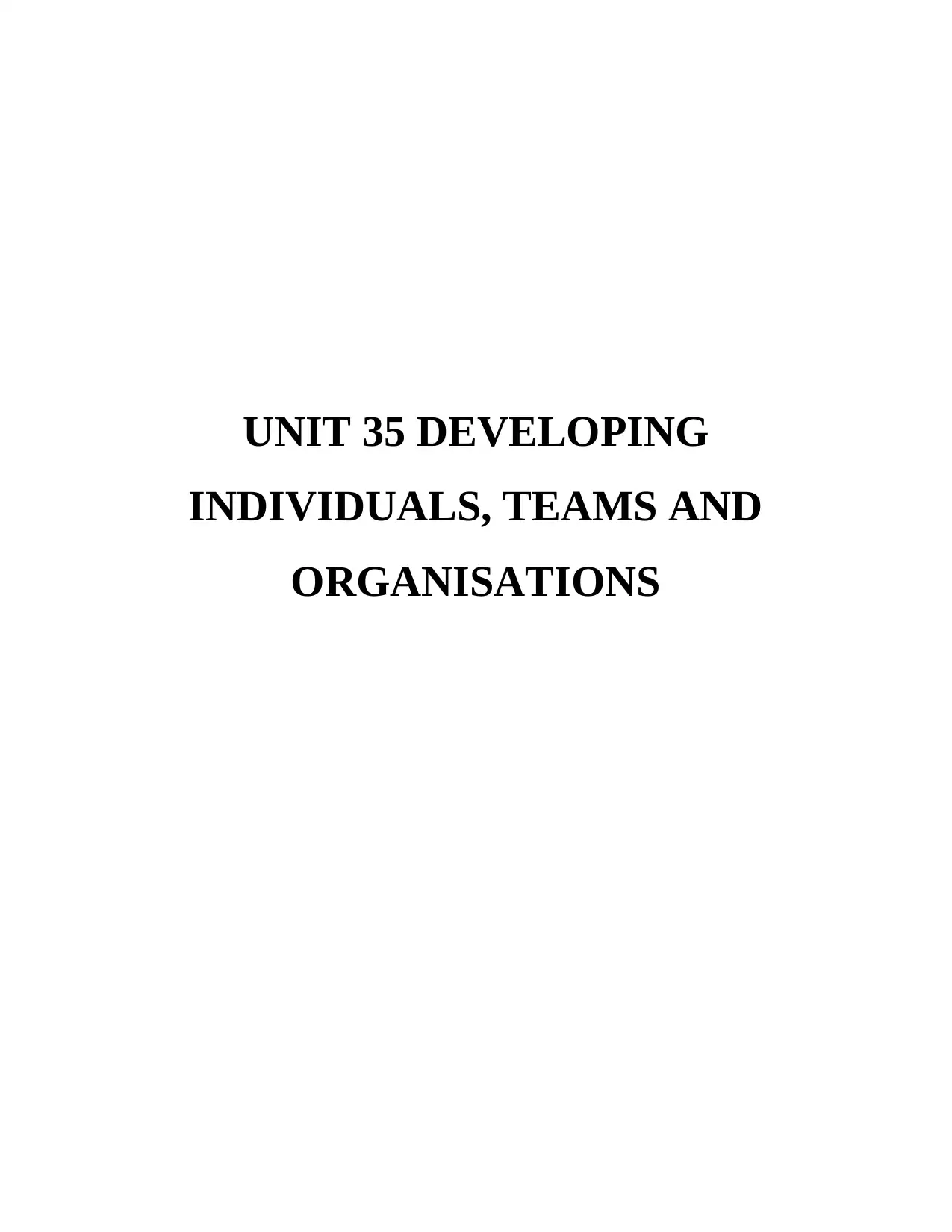
UNIT 35 DEVELOPING
INDIVIDUALS, TEAMS AND
ORGANISATIONS
INDIVIDUALS, TEAMS AND
ORGANISATIONS
Paraphrase This Document
Need a fresh take? Get an instant paraphrase of this document with our AI Paraphraser
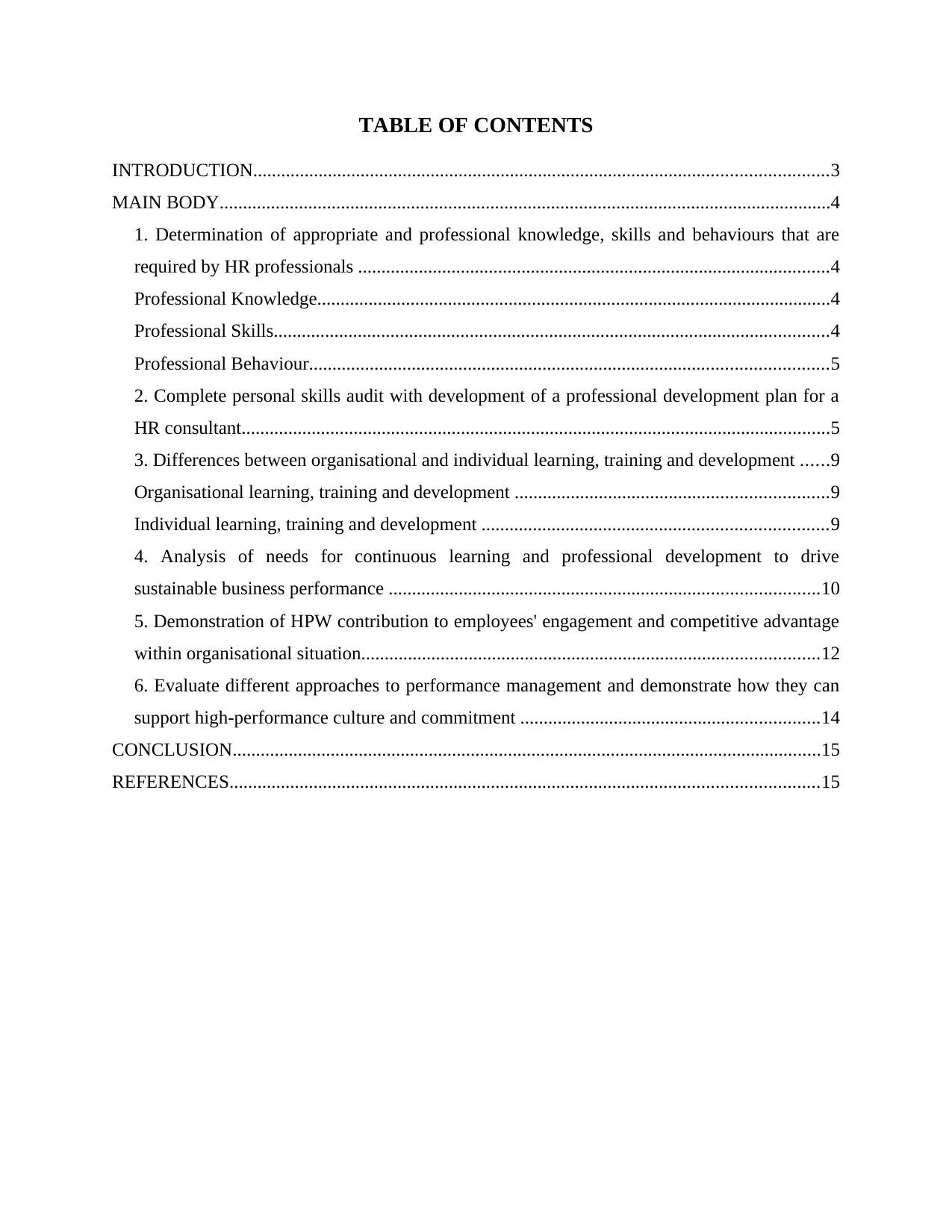
TABLE OF CONTENTS
INTRODUCTION...........................................................................................................................3
MAIN BODY...................................................................................................................................4
1. Determination of appropriate and professional knowledge, skills and behaviours that are
required by HR professionals .....................................................................................................4
Professional Knowledge..............................................................................................................4
Professional Skills.......................................................................................................................4
Professional Behaviour...............................................................................................................5
2. Complete personal skills audit with development of a professional development plan for a
HR consultant..............................................................................................................................5
3. Differences between organisational and individual learning, training and development ......9
Organisational learning, training and development ...................................................................9
Individual learning, training and development ..........................................................................9
4. Analysis of needs for continuous learning and professional development to drive
sustainable business performance ............................................................................................10
5. Demonstration of HPW contribution to employees' engagement and competitive advantage
within organisational situation..................................................................................................12
6. Evaluate different approaches to performance management and demonstrate how they can
support high-performance culture and commitment ................................................................14
CONCLUSION..............................................................................................................................15
REFERENCES..............................................................................................................................15
INTRODUCTION...........................................................................................................................3
MAIN BODY...................................................................................................................................4
1. Determination of appropriate and professional knowledge, skills and behaviours that are
required by HR professionals .....................................................................................................4
Professional Knowledge..............................................................................................................4
Professional Skills.......................................................................................................................4
Professional Behaviour...............................................................................................................5
2. Complete personal skills audit with development of a professional development plan for a
HR consultant..............................................................................................................................5
3. Differences between organisational and individual learning, training and development ......9
Organisational learning, training and development ...................................................................9
Individual learning, training and development ..........................................................................9
4. Analysis of needs for continuous learning and professional development to drive
sustainable business performance ............................................................................................10
5. Demonstration of HPW contribution to employees' engagement and competitive advantage
within organisational situation..................................................................................................12
6. Evaluate different approaches to performance management and demonstrate how they can
support high-performance culture and commitment ................................................................14
CONCLUSION..............................................................................................................................15
REFERENCES..............................................................................................................................15
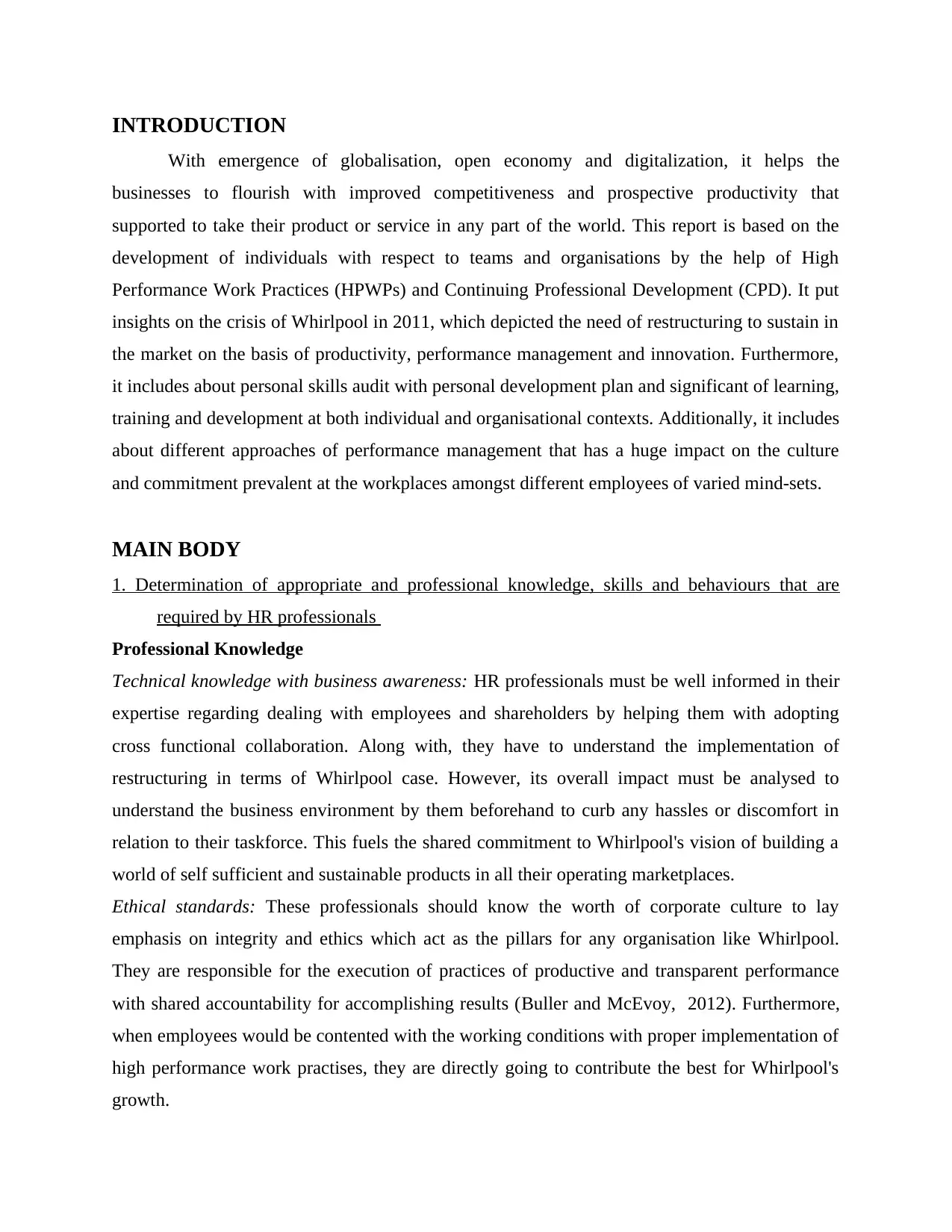
INTRODUCTION
With emergence of globalisation, open economy and digitalization, it helps the
businesses to flourish with improved competitiveness and prospective productivity that
supported to take their product or service in any part of the world. This report is based on the
development of individuals with respect to teams and organisations by the help of High
Performance Work Practices (HPWPs) and Continuing Professional Development (CPD). It put
insights on the crisis of Whirlpool in 2011, which depicted the need of restructuring to sustain in
the market on the basis of productivity, performance management and innovation. Furthermore,
it includes about personal skills audit with personal development plan and significant of learning,
training and development at both individual and organisational contexts. Additionally, it includes
about different approaches of performance management that has a huge impact on the culture
and commitment prevalent at the workplaces amongst different employees of varied mind-sets.
MAIN BODY
1. Determination of appropriate and professional knowledge, skills and behaviours that are
required by HR professionals
Professional Knowledge
Technical knowledge with business awareness: HR professionals must be well informed in their
expertise regarding dealing with employees and shareholders by helping them with adopting
cross functional collaboration. Along with, they have to understand the implementation of
restructuring in terms of Whirlpool case. However, its overall impact must be analysed to
understand the business environment by them beforehand to curb any hassles or discomfort in
relation to their taskforce. This fuels the shared commitment to Whirlpool's vision of building a
world of self sufficient and sustainable products in all their operating marketplaces.
Ethical standards: These professionals should know the worth of corporate culture to lay
emphasis on integrity and ethics which act as the pillars for any organisation like Whirlpool.
They are responsible for the execution of practices of productive and transparent performance
with shared accountability for accomplishing results (Buller and McEvoy, 2012). Furthermore,
when employees would be contented with the working conditions with proper implementation of
high performance work practises, they are directly going to contribute the best for Whirlpool's
growth.
With emergence of globalisation, open economy and digitalization, it helps the
businesses to flourish with improved competitiveness and prospective productivity that
supported to take their product or service in any part of the world. This report is based on the
development of individuals with respect to teams and organisations by the help of High
Performance Work Practices (HPWPs) and Continuing Professional Development (CPD). It put
insights on the crisis of Whirlpool in 2011, which depicted the need of restructuring to sustain in
the market on the basis of productivity, performance management and innovation. Furthermore,
it includes about personal skills audit with personal development plan and significant of learning,
training and development at both individual and organisational contexts. Additionally, it includes
about different approaches of performance management that has a huge impact on the culture
and commitment prevalent at the workplaces amongst different employees of varied mind-sets.
MAIN BODY
1. Determination of appropriate and professional knowledge, skills and behaviours that are
required by HR professionals
Professional Knowledge
Technical knowledge with business awareness: HR professionals must be well informed in their
expertise regarding dealing with employees and shareholders by helping them with adopting
cross functional collaboration. Along with, they have to understand the implementation of
restructuring in terms of Whirlpool case. However, its overall impact must be analysed to
understand the business environment by them beforehand to curb any hassles or discomfort in
relation to their taskforce. This fuels the shared commitment to Whirlpool's vision of building a
world of self sufficient and sustainable products in all their operating marketplaces.
Ethical standards: These professionals should know the worth of corporate culture to lay
emphasis on integrity and ethics which act as the pillars for any organisation like Whirlpool.
They are responsible for the execution of practices of productive and transparent performance
with shared accountability for accomplishing results (Buller and McEvoy, 2012). Furthermore,
when employees would be contented with the working conditions with proper implementation of
high performance work practises, they are directly going to contribute the best for Whirlpool's
growth.
⊘ This is a preview!⊘
Do you want full access?
Subscribe today to unlock all pages.

Trusted by 1+ million students worldwide
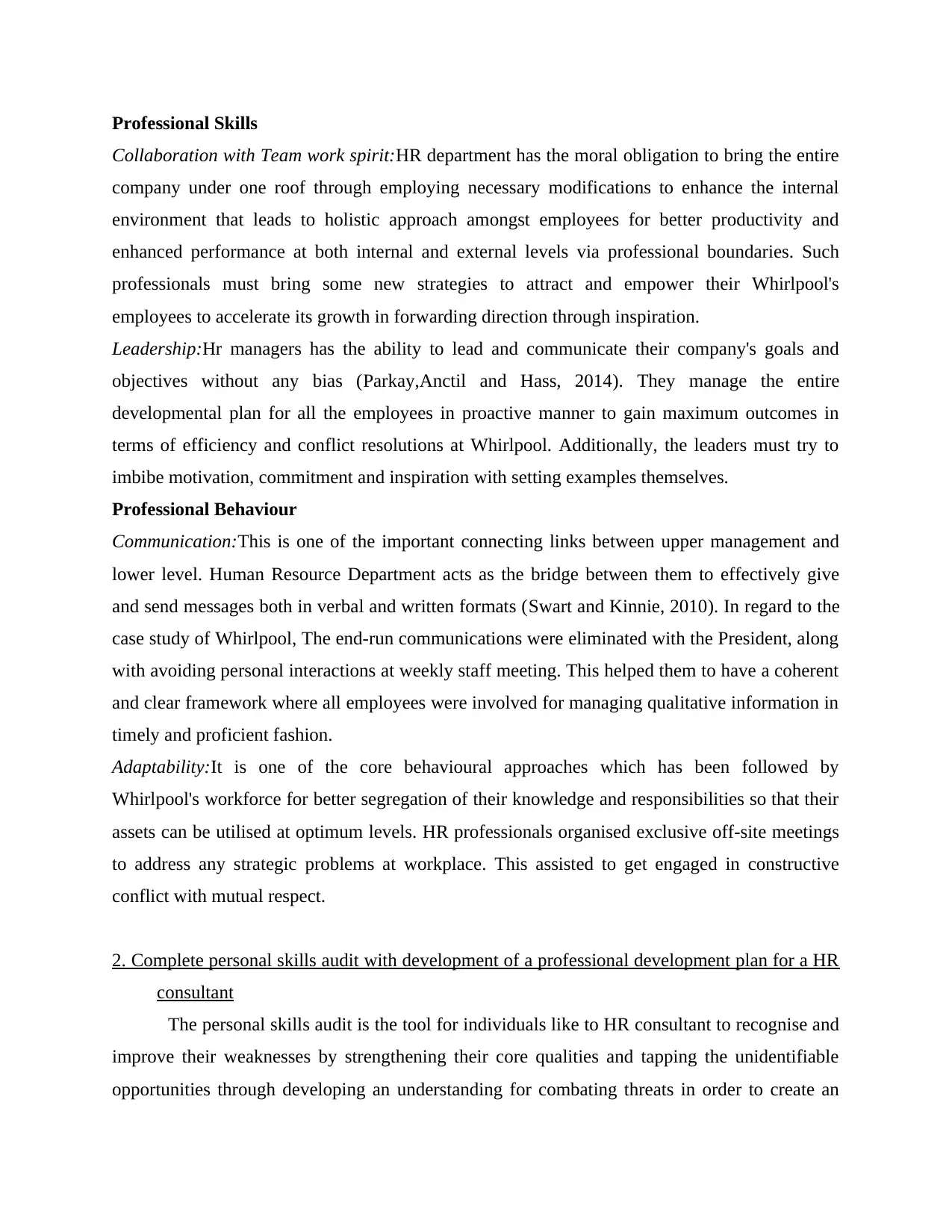
Professional Skills
Collaboration with Team work spirit:HR department has the moral obligation to bring the entire
company under one roof through employing necessary modifications to enhance the internal
environment that leads to holistic approach amongst employees for better productivity and
enhanced performance at both internal and external levels via professional boundaries. Such
professionals must bring some new strategies to attract and empower their Whirlpool's
employees to accelerate its growth in forwarding direction through inspiration.
Leadership:Hr managers has the ability to lead and communicate their company's goals and
objectives without any bias (Parkay,Anctil and Hass, 2014). They manage the entire
developmental plan for all the employees in proactive manner to gain maximum outcomes in
terms of efficiency and conflict resolutions at Whirlpool. Additionally, the leaders must try to
imbibe motivation, commitment and inspiration with setting examples themselves.
Professional Behaviour
Communication:This is one of the important connecting links between upper management and
lower level. Human Resource Department acts as the bridge between them to effectively give
and send messages both in verbal and written formats (Swart and Kinnie, 2010). In regard to the
case study of Whirlpool, The end-run communications were eliminated with the President, along
with avoiding personal interactions at weekly staff meeting. This helped them to have a coherent
and clear framework where all employees were involved for managing qualitative information in
timely and proficient fashion.
Adaptability:It is one of the core behavioural approaches which has been followed by
Whirlpool's workforce for better segregation of their knowledge and responsibilities so that their
assets can be utilised at optimum levels. HR professionals organised exclusive off-site meetings
to address any strategic problems at workplace. This assisted to get engaged in constructive
conflict with mutual respect.
2. Complete personal skills audit with development of a professional development plan for a HR
consultant
The personal skills audit is the tool for individuals like to HR consultant to recognise and
improve their weaknesses by strengthening their core qualities and tapping the unidentifiable
opportunities through developing an understanding for combating threats in order to create an
Collaboration with Team work spirit:HR department has the moral obligation to bring the entire
company under one roof through employing necessary modifications to enhance the internal
environment that leads to holistic approach amongst employees for better productivity and
enhanced performance at both internal and external levels via professional boundaries. Such
professionals must bring some new strategies to attract and empower their Whirlpool's
employees to accelerate its growth in forwarding direction through inspiration.
Leadership:Hr managers has the ability to lead and communicate their company's goals and
objectives without any bias (Parkay,Anctil and Hass, 2014). They manage the entire
developmental plan for all the employees in proactive manner to gain maximum outcomes in
terms of efficiency and conflict resolutions at Whirlpool. Additionally, the leaders must try to
imbibe motivation, commitment and inspiration with setting examples themselves.
Professional Behaviour
Communication:This is one of the important connecting links between upper management and
lower level. Human Resource Department acts as the bridge between them to effectively give
and send messages both in verbal and written formats (Swart and Kinnie, 2010). In regard to the
case study of Whirlpool, The end-run communications were eliminated with the President, along
with avoiding personal interactions at weekly staff meeting. This helped them to have a coherent
and clear framework where all employees were involved for managing qualitative information in
timely and proficient fashion.
Adaptability:It is one of the core behavioural approaches which has been followed by
Whirlpool's workforce for better segregation of their knowledge and responsibilities so that their
assets can be utilised at optimum levels. HR professionals organised exclusive off-site meetings
to address any strategic problems at workplace. This assisted to get engaged in constructive
conflict with mutual respect.
2. Complete personal skills audit with development of a professional development plan for a HR
consultant
The personal skills audit is the tool for individuals like to HR consultant to recognise and
improve their weaknesses by strengthening their core qualities and tapping the unidentifiable
opportunities through developing an understanding for combating threats in order to create an
Paraphrase This Document
Need a fresh take? Get an instant paraphrase of this document with our AI Paraphraser
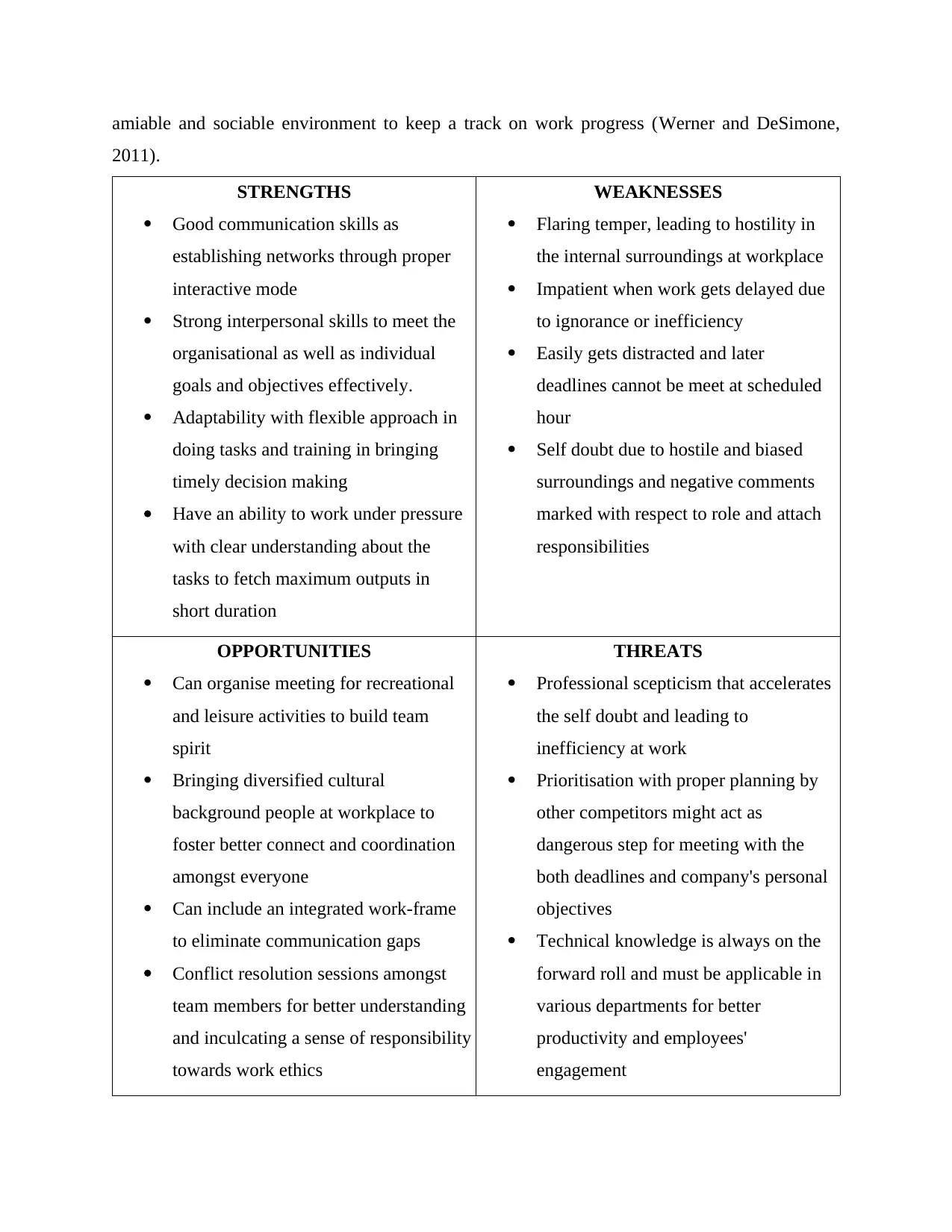
amiable and sociable environment to keep a track on work progress (Werner and DeSimone,
2011).
STRENGTHS
Good communication skills as
establishing networks through proper
interactive mode
Strong interpersonal skills to meet the
organisational as well as individual
goals and objectives effectively.
Adaptability with flexible approach in
doing tasks and training in bringing
timely decision making
Have an ability to work under pressure
with clear understanding about the
tasks to fetch maximum outputs in
short duration
WEAKNESSES
Flaring temper, leading to hostility in
the internal surroundings at workplace
Impatient when work gets delayed due
to ignorance or inefficiency
Easily gets distracted and later
deadlines cannot be meet at scheduled
hour
Self doubt due to hostile and biased
surroundings and negative comments
marked with respect to role and attach
responsibilities
OPPORTUNITIES
Can organise meeting for recreational
and leisure activities to build team
spirit
Bringing diversified cultural
background people at workplace to
foster better connect and coordination
amongst everyone
Can include an integrated work-frame
to eliminate communication gaps
Conflict resolution sessions amongst
team members for better understanding
and inculcating a sense of responsibility
towards work ethics
THREATS
Professional scepticism that accelerates
the self doubt and leading to
inefficiency at work
Prioritisation with proper planning by
other competitors might act as
dangerous step for meeting with the
both deadlines and company's personal
objectives
Technical knowledge is always on the
forward roll and must be applicable in
various departments for better
productivity and employees'
engagement
2011).
STRENGTHS
Good communication skills as
establishing networks through proper
interactive mode
Strong interpersonal skills to meet the
organisational as well as individual
goals and objectives effectively.
Adaptability with flexible approach in
doing tasks and training in bringing
timely decision making
Have an ability to work under pressure
with clear understanding about the
tasks to fetch maximum outputs in
short duration
WEAKNESSES
Flaring temper, leading to hostility in
the internal surroundings at workplace
Impatient when work gets delayed due
to ignorance or inefficiency
Easily gets distracted and later
deadlines cannot be meet at scheduled
hour
Self doubt due to hostile and biased
surroundings and negative comments
marked with respect to role and attach
responsibilities
OPPORTUNITIES
Can organise meeting for recreational
and leisure activities to build team
spirit
Bringing diversified cultural
background people at workplace to
foster better connect and coordination
amongst everyone
Can include an integrated work-frame
to eliminate communication gaps
Conflict resolution sessions amongst
team members for better understanding
and inculcating a sense of responsibility
towards work ethics
THREATS
Professional scepticism that accelerates
the self doubt and leading to
inefficiency at work
Prioritisation with proper planning by
other competitors might act as
dangerous step for meeting with the
both deadlines and company's personal
objectives
Technical knowledge is always on the
forward roll and must be applicable in
various departments for better
productivity and employees'
engagement
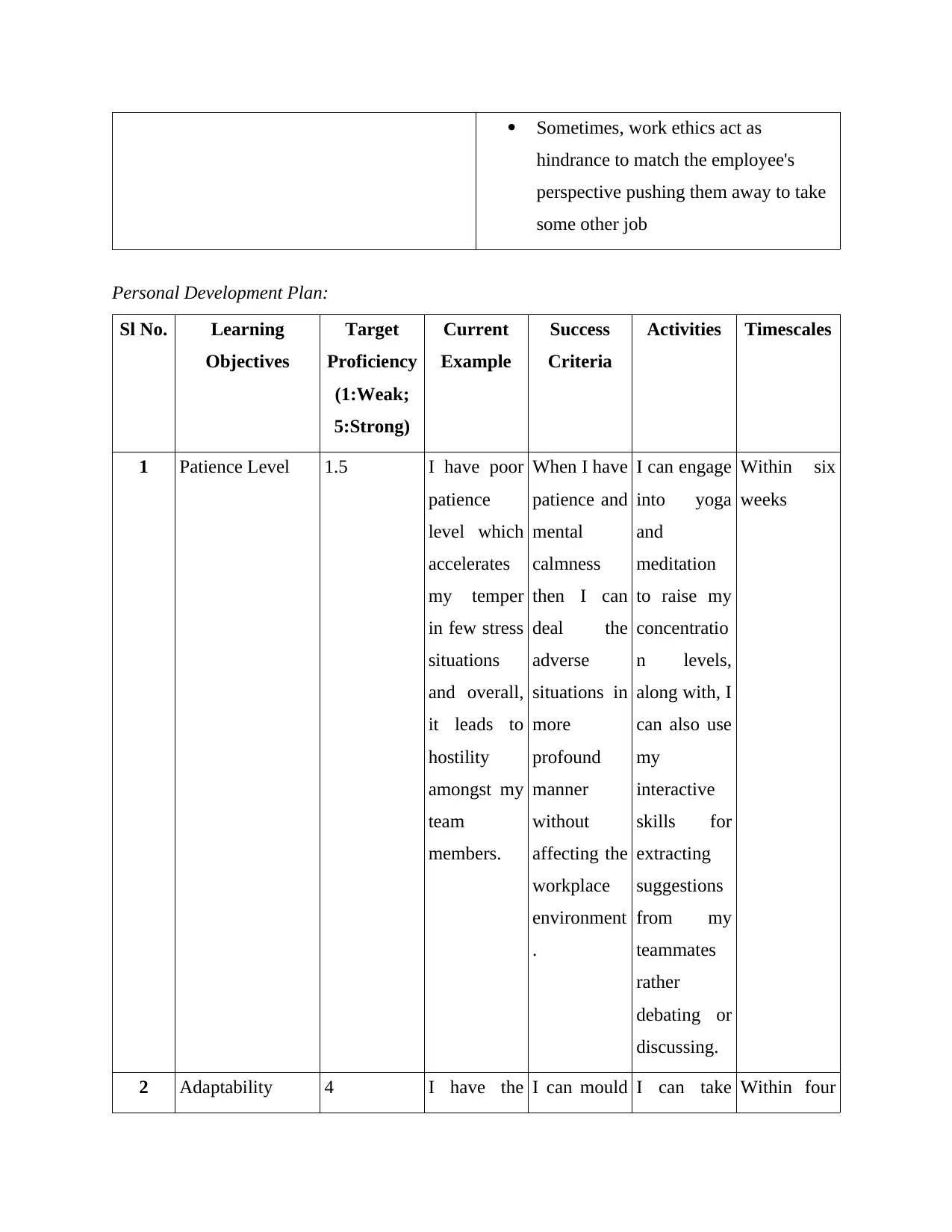
Sometimes, work ethics act as
hindrance to match the employee's
perspective pushing them away to take
some other job
Personal Development Plan:
Sl No. Learning
Objectives
Target
Proficiency
(1:Weak;
5:Strong)
Current
Example
Success
Criteria
Activities Timescales
1 Patience Level 1.5 I have poor
patience
level which
accelerates
my temper
in few stress
situations
and overall,
it leads to
hostility
amongst my
team
members.
When I have
patience and
mental
calmness
then I can
deal the
adverse
situations in
more
profound
manner
without
affecting the
workplace
environment
.
I can engage
into yoga
and
meditation
to raise my
concentratio
n levels,
along with, I
can also use
my
interactive
skills for
extracting
suggestions
from my
teammates
rather
debating or
discussing.
Within six
weeks
2 Adaptability 4 I have the I can mould I can take Within four
hindrance to match the employee's
perspective pushing them away to take
some other job
Personal Development Plan:
Sl No. Learning
Objectives
Target
Proficiency
(1:Weak;
5:Strong)
Current
Example
Success
Criteria
Activities Timescales
1 Patience Level 1.5 I have poor
patience
level which
accelerates
my temper
in few stress
situations
and overall,
it leads to
hostility
amongst my
team
members.
When I have
patience and
mental
calmness
then I can
deal the
adverse
situations in
more
profound
manner
without
affecting the
workplace
environment
.
I can engage
into yoga
and
meditation
to raise my
concentratio
n levels,
along with, I
can also use
my
interactive
skills for
extracting
suggestions
from my
teammates
rather
debating or
discussing.
Within six
weeks
2 Adaptability 4 I have the I can mould I can take Within four
⊘ This is a preview!⊘
Do you want full access?
Subscribe today to unlock all pages.

Trusted by 1+ million students worldwide
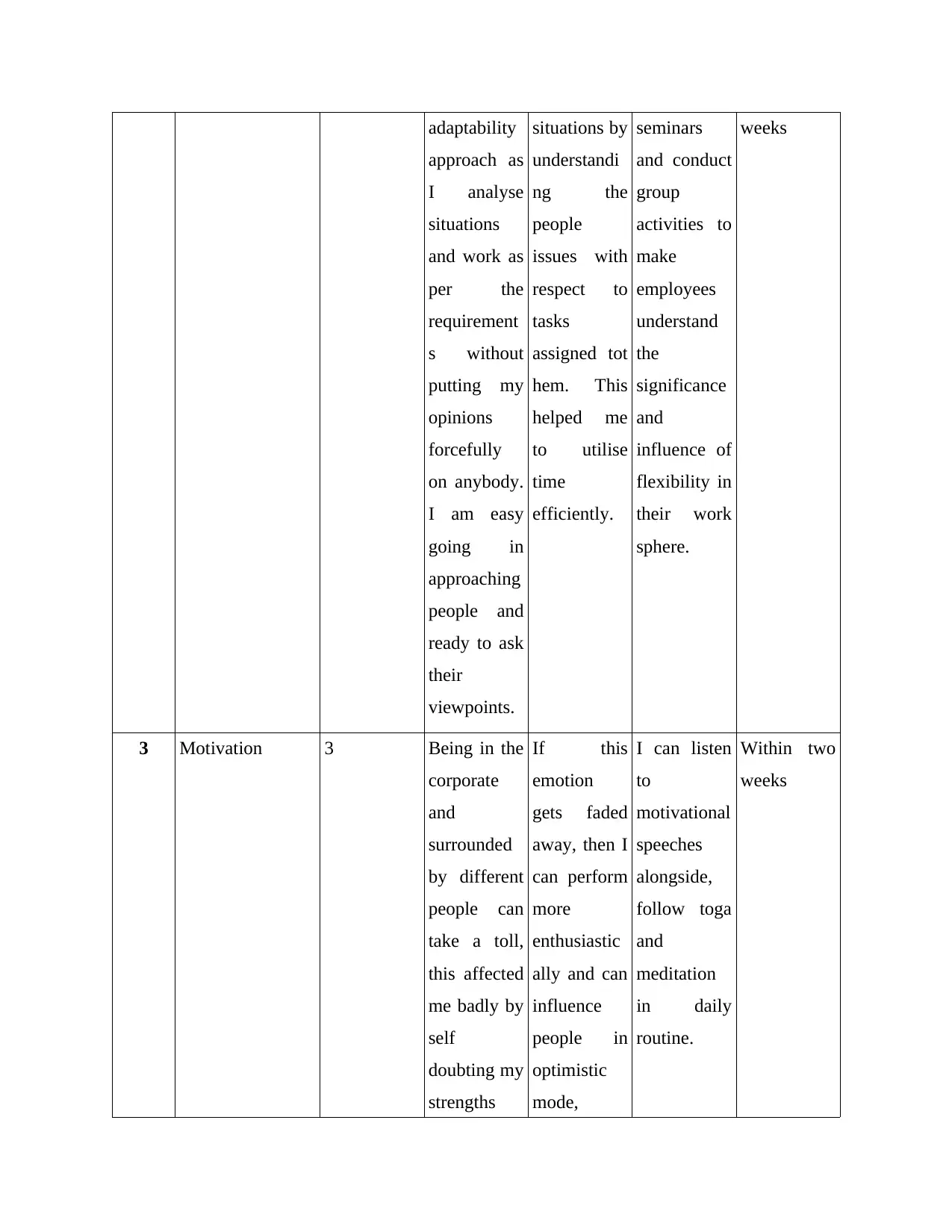
adaptability
approach as
I analyse
situations
and work as
per the
requirement
s without
putting my
opinions
forcefully
on anybody.
I am easy
going in
approaching
people and
ready to ask
their
viewpoints.
situations by
understandi
ng the
people
issues with
respect to
tasks
assigned tot
hem. This
helped me
to utilise
time
efficiently.
seminars
and conduct
group
activities to
make
employees
understand
the
significance
and
influence of
flexibility in
their work
sphere.
weeks
3 Motivation 3 Being in the
corporate
and
surrounded
by different
people can
take a toll,
this affected
me badly by
self
doubting my
strengths
If this
emotion
gets faded
away, then I
can perform
more
enthusiastic
ally and can
influence
people in
optimistic
mode,
I can listen
to
motivational
speeches
alongside,
follow toga
and
meditation
in daily
routine.
Within two
weeks
approach as
I analyse
situations
and work as
per the
requirement
s without
putting my
opinions
forcefully
on anybody.
I am easy
going in
approaching
people and
ready to ask
their
viewpoints.
situations by
understandi
ng the
people
issues with
respect to
tasks
assigned tot
hem. This
helped me
to utilise
time
efficiently.
seminars
and conduct
group
activities to
make
employees
understand
the
significance
and
influence of
flexibility in
their work
sphere.
weeks
3 Motivation 3 Being in the
corporate
and
surrounded
by different
people can
take a toll,
this affected
me badly by
self
doubting my
strengths
If this
emotion
gets faded
away, then I
can perform
more
enthusiastic
ally and can
influence
people in
optimistic
mode,
I can listen
to
motivational
speeches
alongside,
follow toga
and
meditation
in daily
routine.
Within two
weeks
Paraphrase This Document
Need a fresh take? Get an instant paraphrase of this document with our AI Paraphraser

and work
ethics. Thus,
it affected
my profile
in
unpleasant
manner.
leading to
growth of
company in
leaps and
bounds.
4 Technical
knowledge
3.5 One must
have
knowledge
about its
field in
complete
and proper
form. I must
have the
updated
news to
keep myself
up-to-date
related to
the latest
tools,
technologies
etc.
I will be
updated
then can
contribute to
organisation
's success
rate through
employing
such
beneficial
updated
versions.
I can follow
news and
journals.
Also, I can
install
applications
to know
about the
trends
followed by
other
companies.
Within three
weeks
3. Differences between organisational and individual learning, training and development
BASIS Organisational learning, training
and development
Individual learning, training and
development
ethics. Thus,
it affected
my profile
in
unpleasant
manner.
leading to
growth of
company in
leaps and
bounds.
4 Technical
knowledge
3.5 One must
have
knowledge
about its
field in
complete
and proper
form. I must
have the
updated
news to
keep myself
up-to-date
related to
the latest
tools,
technologies
etc.
I will be
updated
then can
contribute to
organisation
's success
rate through
employing
such
beneficial
updated
versions.
I can follow
news and
journals.
Also, I can
install
applications
to know
about the
trends
followed by
other
companies.
Within three
weeks
3. Differences between organisational and individual learning, training and development
BASIS Organisational learning, training
and development
Individual learning, training and
development
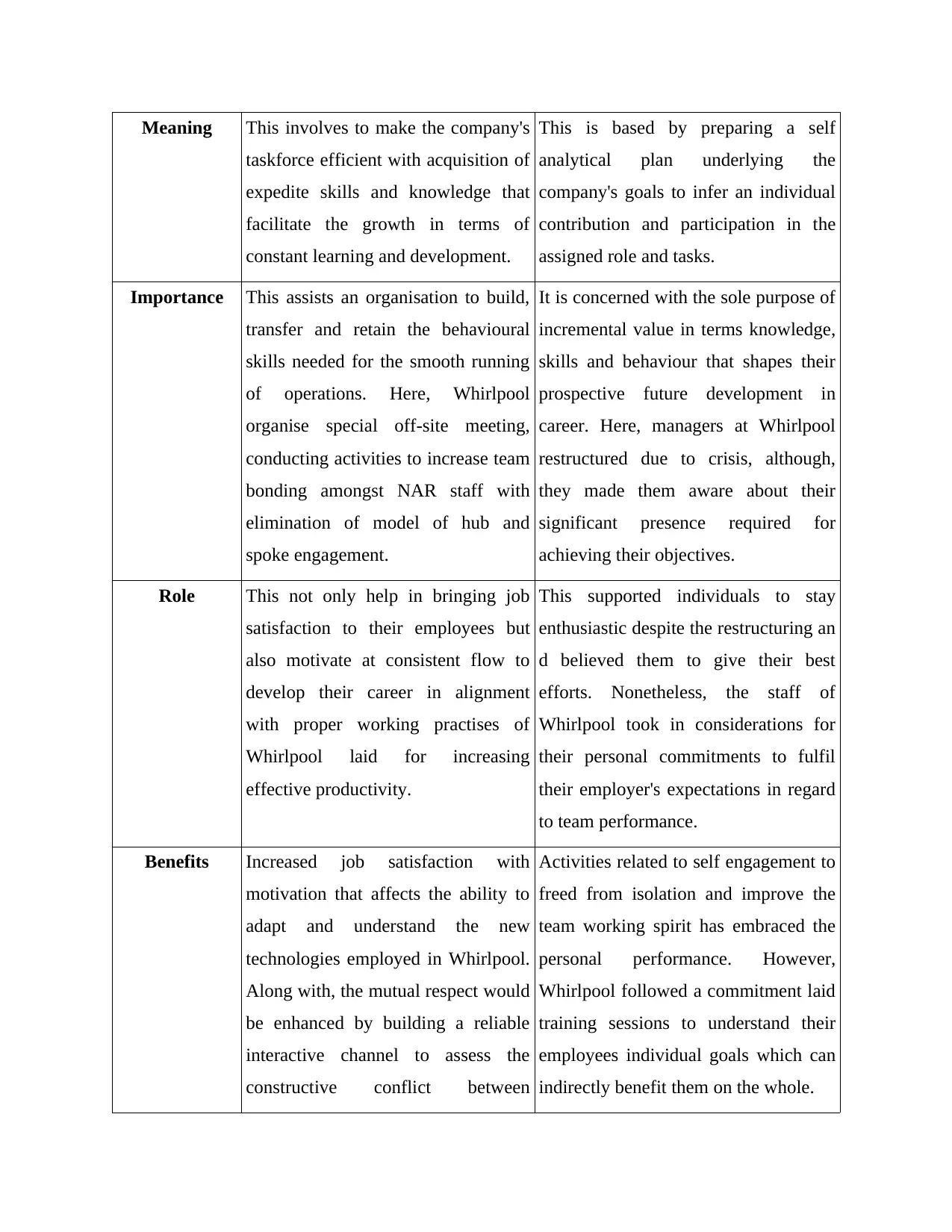
Meaning This involves to make the company's
taskforce efficient with acquisition of
expedite skills and knowledge that
facilitate the growth in terms of
constant learning and development.
This is based by preparing a self
analytical plan underlying the
company's goals to infer an individual
contribution and participation in the
assigned role and tasks.
Importance This assists an organisation to build,
transfer and retain the behavioural
skills needed for the smooth running
of operations. Here, Whirlpool
organise special off-site meeting,
conducting activities to increase team
bonding amongst NAR staff with
elimination of model of hub and
spoke engagement.
It is concerned with the sole purpose of
incremental value in terms knowledge,
skills and behaviour that shapes their
prospective future development in
career. Here, managers at Whirlpool
restructured due to crisis, although,
they made them aware about their
significant presence required for
achieving their objectives.
Role This not only help in bringing job
satisfaction to their employees but
also motivate at consistent flow to
develop their career in alignment
with proper working practises of
Whirlpool laid for increasing
effective productivity.
This supported individuals to stay
enthusiastic despite the restructuring an
d believed them to give their best
efforts. Nonetheless, the staff of
Whirlpool took in considerations for
their personal commitments to fulfil
their employer's expectations in regard
to team performance.
Benefits Increased job satisfaction with
motivation that affects the ability to
adapt and understand the new
technologies employed in Whirlpool.
Along with, the mutual respect would
be enhanced by building a reliable
interactive channel to assess the
constructive conflict between
Activities related to self engagement to
freed from isolation and improve the
team working spirit has embraced the
personal performance. However,
Whirlpool followed a commitment laid
training sessions to understand their
employees individual goals which can
indirectly benefit them on the whole.
taskforce efficient with acquisition of
expedite skills and knowledge that
facilitate the growth in terms of
constant learning and development.
This is based by preparing a self
analytical plan underlying the
company's goals to infer an individual
contribution and participation in the
assigned role and tasks.
Importance This assists an organisation to build,
transfer and retain the behavioural
skills needed for the smooth running
of operations. Here, Whirlpool
organise special off-site meeting,
conducting activities to increase team
bonding amongst NAR staff with
elimination of model of hub and
spoke engagement.
It is concerned with the sole purpose of
incremental value in terms knowledge,
skills and behaviour that shapes their
prospective future development in
career. Here, managers at Whirlpool
restructured due to crisis, although,
they made them aware about their
significant presence required for
achieving their objectives.
Role This not only help in bringing job
satisfaction to their employees but
also motivate at consistent flow to
develop their career in alignment
with proper working practises of
Whirlpool laid for increasing
effective productivity.
This supported individuals to stay
enthusiastic despite the restructuring an
d believed them to give their best
efforts. Nonetheless, the staff of
Whirlpool took in considerations for
their personal commitments to fulfil
their employer's expectations in regard
to team performance.
Benefits Increased job satisfaction with
motivation that affects the ability to
adapt and understand the new
technologies employed in Whirlpool.
Along with, the mutual respect would
be enhanced by building a reliable
interactive channel to assess the
constructive conflict between
Activities related to self engagement to
freed from isolation and improve the
team working spirit has embraced the
personal performance. However,
Whirlpool followed a commitment laid
training sessions to understand their
employees individual goals which can
indirectly benefit them on the whole.
⊘ This is a preview!⊘
Do you want full access?
Subscribe today to unlock all pages.

Trusted by 1+ million students worldwide
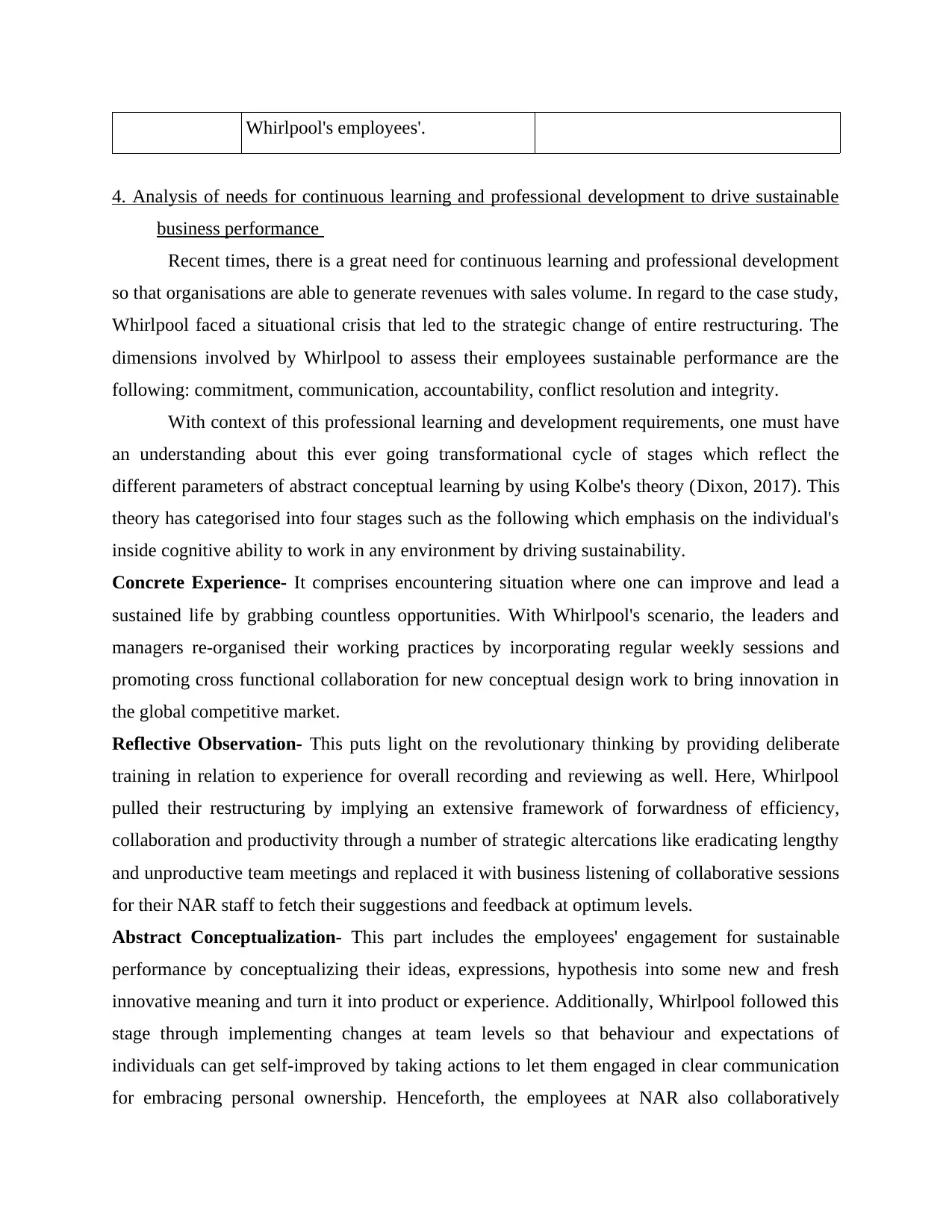
Whirlpool's employees'.
4. Analysis of needs for continuous learning and professional development to drive sustainable
business performance
Recent times, there is a great need for continuous learning and professional development
so that organisations are able to generate revenues with sales volume. In regard to the case study,
Whirlpool faced a situational crisis that led to the strategic change of entire restructuring. The
dimensions involved by Whirlpool to assess their employees sustainable performance are the
following: commitment, communication, accountability, conflict resolution and integrity.
With context of this professional learning and development requirements, one must have
an understanding about this ever going transformational cycle of stages which reflect the
different parameters of abstract conceptual learning by using Kolbe's theory (Dixon, 2017). This
theory has categorised into four stages such as the following which emphasis on the individual's
inside cognitive ability to work in any environment by driving sustainability.
Concrete Experience- It comprises encountering situation where one can improve and lead a
sustained life by grabbing countless opportunities. With Whirlpool's scenario, the leaders and
managers re-organised their working practices by incorporating regular weekly sessions and
promoting cross functional collaboration for new conceptual design work to bring innovation in
the global competitive market.
Reflective Observation- This puts light on the revolutionary thinking by providing deliberate
training in relation to experience for overall recording and reviewing as well. Here, Whirlpool
pulled their restructuring by implying an extensive framework of forwardness of efficiency,
collaboration and productivity through a number of strategic altercations like eradicating lengthy
and unproductive team meetings and replaced it with business listening of collaborative sessions
for their NAR staff to fetch their suggestions and feedback at optimum levels.
Abstract Conceptualization- This part includes the employees' engagement for sustainable
performance by conceptualizing their ideas, expressions, hypothesis into some new and fresh
innovative meaning and turn it into product or experience. Additionally, Whirlpool followed this
stage through implementing changes at team levels so that behaviour and expectations of
individuals can get self-improved by taking actions to let them engaged in clear communication
for embracing personal ownership. Henceforth, the employees at NAR also collaboratively
4. Analysis of needs for continuous learning and professional development to drive sustainable
business performance
Recent times, there is a great need for continuous learning and professional development
so that organisations are able to generate revenues with sales volume. In regard to the case study,
Whirlpool faced a situational crisis that led to the strategic change of entire restructuring. The
dimensions involved by Whirlpool to assess their employees sustainable performance are the
following: commitment, communication, accountability, conflict resolution and integrity.
With context of this professional learning and development requirements, one must have
an understanding about this ever going transformational cycle of stages which reflect the
different parameters of abstract conceptual learning by using Kolbe's theory (Dixon, 2017). This
theory has categorised into four stages such as the following which emphasis on the individual's
inside cognitive ability to work in any environment by driving sustainability.
Concrete Experience- It comprises encountering situation where one can improve and lead a
sustained life by grabbing countless opportunities. With Whirlpool's scenario, the leaders and
managers re-organised their working practices by incorporating regular weekly sessions and
promoting cross functional collaboration for new conceptual design work to bring innovation in
the global competitive market.
Reflective Observation- This puts light on the revolutionary thinking by providing deliberate
training in relation to experience for overall recording and reviewing as well. Here, Whirlpool
pulled their restructuring by implying an extensive framework of forwardness of efficiency,
collaboration and productivity through a number of strategic altercations like eradicating lengthy
and unproductive team meetings and replaced it with business listening of collaborative sessions
for their NAR staff to fetch their suggestions and feedback at optimum levels.
Abstract Conceptualization- This part includes the employees' engagement for sustainable
performance by conceptualizing their ideas, expressions, hypothesis into some new and fresh
innovative meaning and turn it into product or experience. Additionally, Whirlpool followed this
stage through implementing changes at team levels so that behaviour and expectations of
individuals can get self-improved by taking actions to let them engaged in clear communication
for embracing personal ownership. Henceforth, the employees at NAR also collaboratively
Paraphrase This Document
Need a fresh take? Get an instant paraphrase of this document with our AI Paraphraser
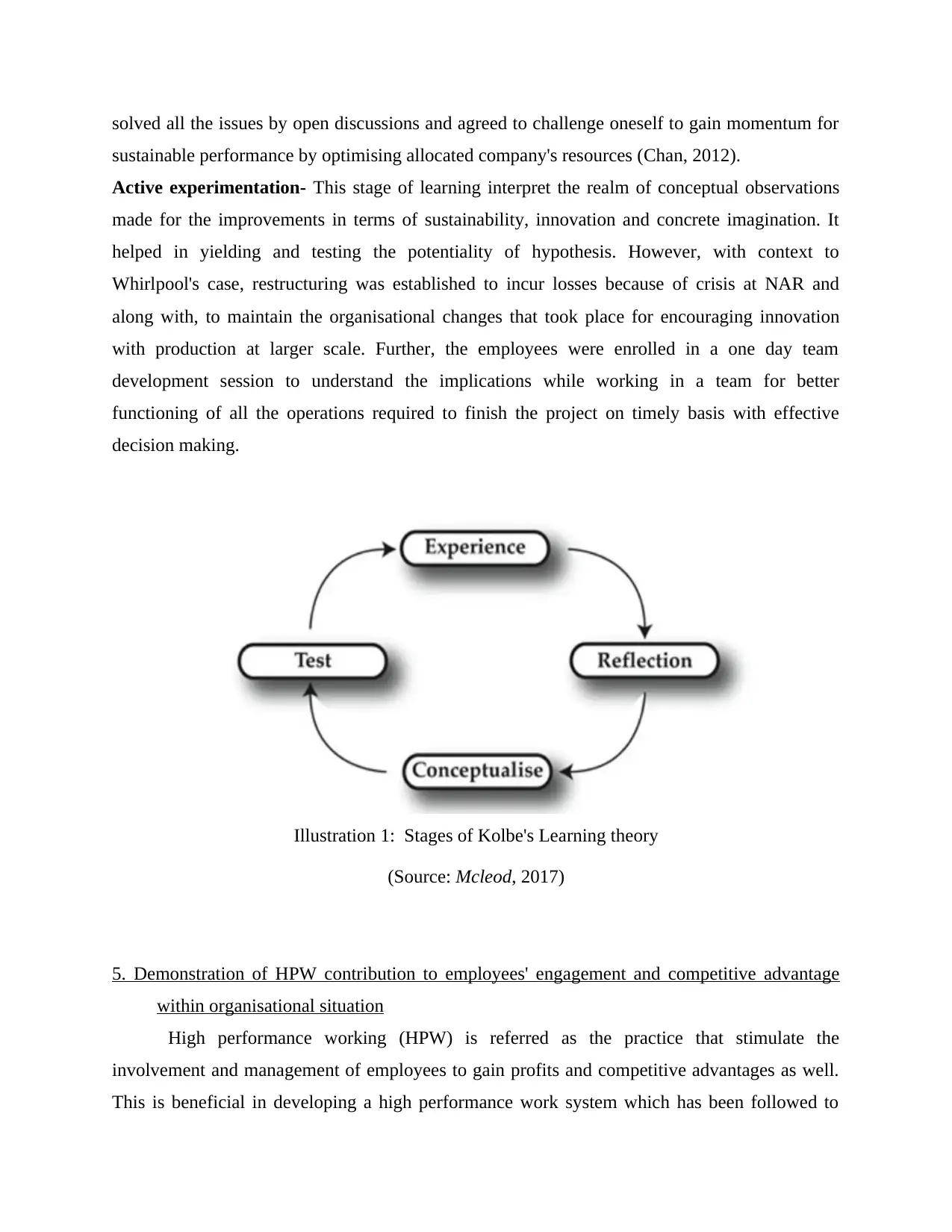
solved all the issues by open discussions and agreed to challenge oneself to gain momentum for
sustainable performance by optimising allocated company's resources (Chan, 2012).
Active experimentation- This stage of learning interpret the realm of conceptual observations
made for the improvements in terms of sustainability, innovation and concrete imagination. It
helped in yielding and testing the potentiality of hypothesis. However, with context to
Whirlpool's case, restructuring was established to incur losses because of crisis at NAR and
along with, to maintain the organisational changes that took place for encouraging innovation
with production at larger scale. Further, the employees were enrolled in a one day team
development session to understand the implications while working in a team for better
functioning of all the operations required to finish the project on timely basis with effective
decision making.
5. Demonstration of HPW contribution to employees' engagement and competitive advantage
within organisational situation
High performance working (HPW) is referred as the practice that stimulate the
involvement and management of employees to gain profits and competitive advantages as well.
This is beneficial in developing a high performance work system which has been followed to
Illustration 1: Stages of Kolbe's Learning theory
(Source: Mcleod, 2017)
sustainable performance by optimising allocated company's resources (Chan, 2012).
Active experimentation- This stage of learning interpret the realm of conceptual observations
made for the improvements in terms of sustainability, innovation and concrete imagination. It
helped in yielding and testing the potentiality of hypothesis. However, with context to
Whirlpool's case, restructuring was established to incur losses because of crisis at NAR and
along with, to maintain the organisational changes that took place for encouraging innovation
with production at larger scale. Further, the employees were enrolled in a one day team
development session to understand the implications while working in a team for better
functioning of all the operations required to finish the project on timely basis with effective
decision making.
5. Demonstration of HPW contribution to employees' engagement and competitive advantage
within organisational situation
High performance working (HPW) is referred as the practice that stimulate the
involvement and management of employees to gain profits and competitive advantages as well.
This is beneficial in developing a high performance work system which has been followed to
Illustration 1: Stages of Kolbe's Learning theory
(Source: Mcleod, 2017)
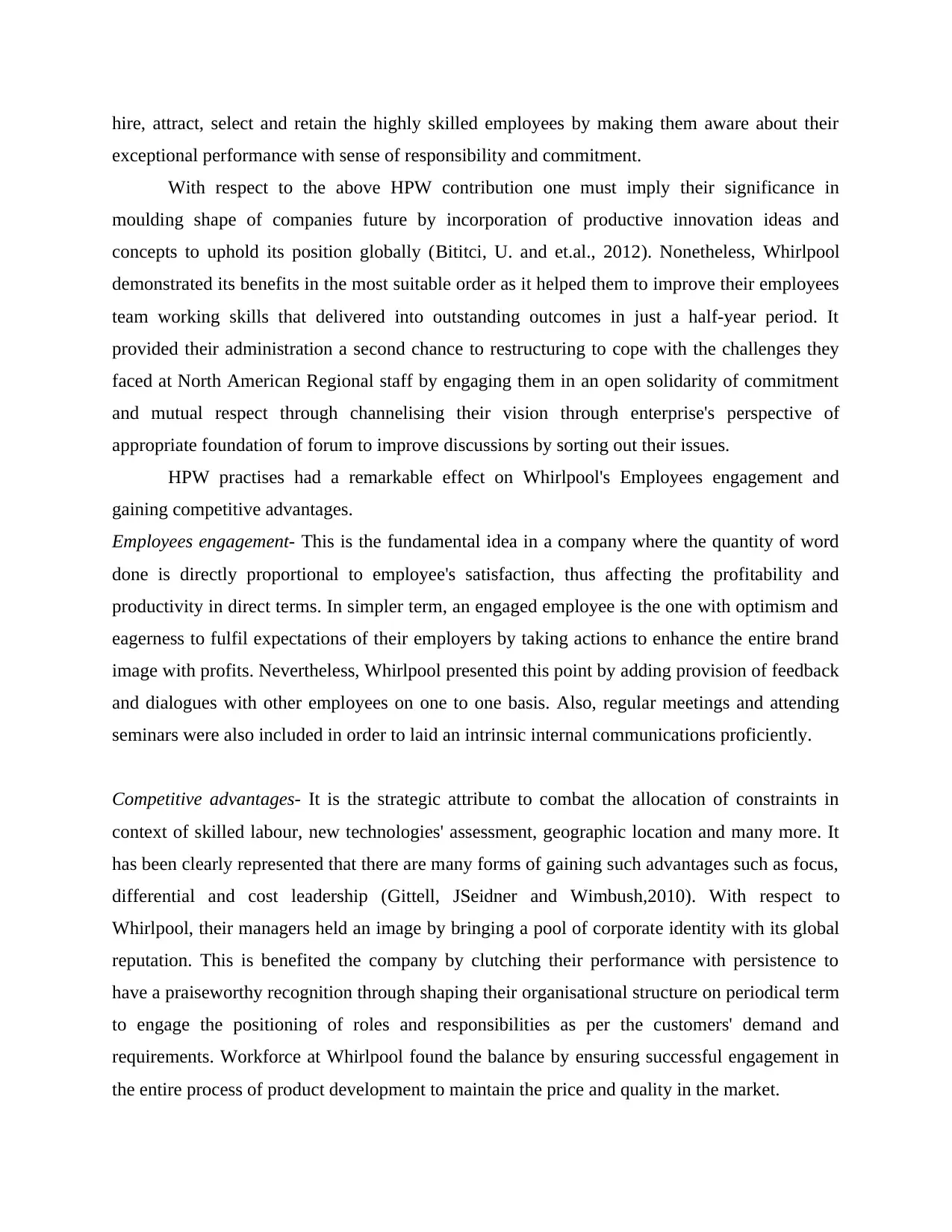
hire, attract, select and retain the highly skilled employees by making them aware about their
exceptional performance with sense of responsibility and commitment.
With respect to the above HPW contribution one must imply their significance in
moulding shape of companies future by incorporation of productive innovation ideas and
concepts to uphold its position globally (Bititci, U. and et.al., 2012). Nonetheless, Whirlpool
demonstrated its benefits in the most suitable order as it helped them to improve their employees
team working skills that delivered into outstanding outcomes in just a half-year period. It
provided their administration a second chance to restructuring to cope with the challenges they
faced at North American Regional staff by engaging them in an open solidarity of commitment
and mutual respect through channelising their vision through enterprise's perspective of
appropriate foundation of forum to improve discussions by sorting out their issues.
HPW practises had a remarkable effect on Whirlpool's Employees engagement and
gaining competitive advantages.
Employees engagement- This is the fundamental idea in a company where the quantity of word
done is directly proportional to employee's satisfaction, thus affecting the profitability and
productivity in direct terms. In simpler term, an engaged employee is the one with optimism and
eagerness to fulfil expectations of their employers by taking actions to enhance the entire brand
image with profits. Nevertheless, Whirlpool presented this point by adding provision of feedback
and dialogues with other employees on one to one basis. Also, regular meetings and attending
seminars were also included in order to laid an intrinsic internal communications proficiently.
Competitive advantages- It is the strategic attribute to combat the allocation of constraints in
context of skilled labour, new technologies' assessment, geographic location and many more. It
has been clearly represented that there are many forms of gaining such advantages such as focus,
differential and cost leadership (Gittell, JSeidner and Wimbush,2010). With respect to
Whirlpool, their managers held an image by bringing a pool of corporate identity with its global
reputation. This is benefited the company by clutching their performance with persistence to
have a praiseworthy recognition through shaping their organisational structure on periodical term
to engage the positioning of roles and responsibilities as per the customers' demand and
requirements. Workforce at Whirlpool found the balance by ensuring successful engagement in
the entire process of product development to maintain the price and quality in the market.
exceptional performance with sense of responsibility and commitment.
With respect to the above HPW contribution one must imply their significance in
moulding shape of companies future by incorporation of productive innovation ideas and
concepts to uphold its position globally (Bititci, U. and et.al., 2012). Nonetheless, Whirlpool
demonstrated its benefits in the most suitable order as it helped them to improve their employees
team working skills that delivered into outstanding outcomes in just a half-year period. It
provided their administration a second chance to restructuring to cope with the challenges they
faced at North American Regional staff by engaging them in an open solidarity of commitment
and mutual respect through channelising their vision through enterprise's perspective of
appropriate foundation of forum to improve discussions by sorting out their issues.
HPW practises had a remarkable effect on Whirlpool's Employees engagement and
gaining competitive advantages.
Employees engagement- This is the fundamental idea in a company where the quantity of word
done is directly proportional to employee's satisfaction, thus affecting the profitability and
productivity in direct terms. In simpler term, an engaged employee is the one with optimism and
eagerness to fulfil expectations of their employers by taking actions to enhance the entire brand
image with profits. Nevertheless, Whirlpool presented this point by adding provision of feedback
and dialogues with other employees on one to one basis. Also, regular meetings and attending
seminars were also included in order to laid an intrinsic internal communications proficiently.
Competitive advantages- It is the strategic attribute to combat the allocation of constraints in
context of skilled labour, new technologies' assessment, geographic location and many more. It
has been clearly represented that there are many forms of gaining such advantages such as focus,
differential and cost leadership (Gittell, JSeidner and Wimbush,2010). With respect to
Whirlpool, their managers held an image by bringing a pool of corporate identity with its global
reputation. This is benefited the company by clutching their performance with persistence to
have a praiseworthy recognition through shaping their organisational structure on periodical term
to engage the positioning of roles and responsibilities as per the customers' demand and
requirements. Workforce at Whirlpool found the balance by ensuring successful engagement in
the entire process of product development to maintain the price and quality in the market.
⊘ This is a preview!⊘
Do you want full access?
Subscribe today to unlock all pages.

Trusted by 1+ million students worldwide
1 out of 16
Related Documents
Your All-in-One AI-Powered Toolkit for Academic Success.
+13062052269
info@desklib.com
Available 24*7 on WhatsApp / Email
![[object Object]](/_next/static/media/star-bottom.7253800d.svg)
Unlock your academic potential
Copyright © 2020–2025 A2Z Services. All Rights Reserved. Developed and managed by ZUCOL.





